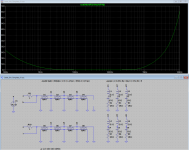Well, Hans, that was something I didn't expect!
The cable improved that much... without the modification it sounded dull, the imaging was blurred, boring all in all ... but then: dynamics, imaging, almost everything improved considerably. With my former cable the soundstage was a bit deeper, but now there is more vertical spatial differentiation.
Im not good in describing listening impressions and everyone listens different, but these are not subjective perceptions.
One of the best value for the money improvements!
Boris
The cable improved that much... without the modification it sounded dull, the imaging was blurred, boring all in all ... but then: dynamics, imaging, almost everything improved considerably. With my former cable the soundstage was a bit deeper, but now there is more vertical spatial differentiation.
Im not good in describing listening impressions and everyone listens different, but these are not subjective perceptions.
One of the best value for the money improvements!
Boris
Hi Hans,
the surprisingly positive result encourages me to make further experiments…
As I said, I have used DIY solid core cable most of the time with very good results.
A simple twisted enamelled copper wire sounds (to me) a lot better than the zip-cord without the modification.
So the next logical step for me is to make a cable with solid core wire with the modification.
I understood, how to achieve the desired capacitance for each network.
Is there a way to calculate the values for the series resistance and inductance?
I’m not that good with LTSpice. Is there a hint in a Brisson patent?
Apart from that, I made a mistake when calculating the 0,45nH Inductors and the resulting
inductance is rather ~100nH. But the result was very good anyways.
I ‘m going to correct that to see (hear) if has an effect.
Cheers, Boris
the surprisingly positive result encourages me to make further experiments…
As I said, I have used DIY solid core cable most of the time with very good results.
A simple twisted enamelled copper wire sounds (to me) a lot better than the zip-cord without the modification.
So the next logical step for me is to make a cable with solid core wire with the modification.
I understood, how to achieve the desired capacitance for each network.
Is there a way to calculate the values for the series resistance and inductance?
I’m not that good with LTSpice. Is there a hint in a Brisson patent?
Apart from that, I made a mistake when calculating the 0,45nH Inductors and the resulting
inductance is rather ~100nH. But the result was very good anyways.
I ‘m going to correct that to see (hear) if has an effect.
Cheers, Boris
Hi Boris,
Great to hear that you achieved such positive results.
Send me the measured inductance and capacity of your twisted solid core and I’ll do the calculation for you.
Hans
Great to hear that you achieved such positive results.
Send me the measured inductance and capacity of your twisted solid core and I’ll do the calculation for you.
Hans
Many thanks for the offer. This will take some time as I go on vacation next week.
After that I will buy the solid core wire and make the cable. I will contact you when I'm back.
Since I'm in the process of building new speakers (open source monkey coffin) I would like to to make cables for them right away. My plan is to to make the cable Z switchable...
Boris
After that I will buy the solid core wire and make the cable. I will contact you when I'm back.
Since I'm in the process of building new speakers (open source monkey coffin) I would like to to make cables for them right away. My plan is to to make the cable Z switchable...
Boris
Short form- convert the effective impedance of the cable to match that of the speaker. Hans should be able to explain in better detail.
Hi Demian,
Did you already find the opportunity to collect some of your MIT speaker cables ?
Hans
Did you already find the opportunity to collect some of your MIT speaker cables ?
Hans
Short form- convert the effective impedance of the cable to match that of the speaker. Hans should be able to explain in better detail.
Funny theory but wrong
Hans:
I have not found them. I may have given them way some years ago. Just too much of this stuff to accumulate.
I have not found them. I may have given them way some years ago. Just too much of this stuff to accumulate.
Funny theory but wrong
It is not at all a theory to start with, it was something that I came across when measuring an MIT cable, who’s Char. Imp. unexpectedly was almost a copy of my LS impedance.
But it seems you know better, so let’s hear what light you can shed on the subject.
Hans
Hans - do you use 3 compensation circuits regardless of length? Beginning, mid and end - or is its certain number per meter?
//
//
For short cables 1 or 2 compensation circuits are probably more practical. As from 1.5 meter and longer, 3 compensation circuits seem to be an optimum, at least from a simulation point of view.Hans - do you use 3 compensation circuits regardless of length? Beginning, mid and end - or is its certain number per meter?
//
What the effect is on having 1 or more networks on the auditory perception is not something I tried, because my initial attempt was to copy the transfer characteristic of a certain MIT cable having 3 compensation networks.
Hans
- Home
- General Interest
- Everything Else
- Zip cord for speaker test


